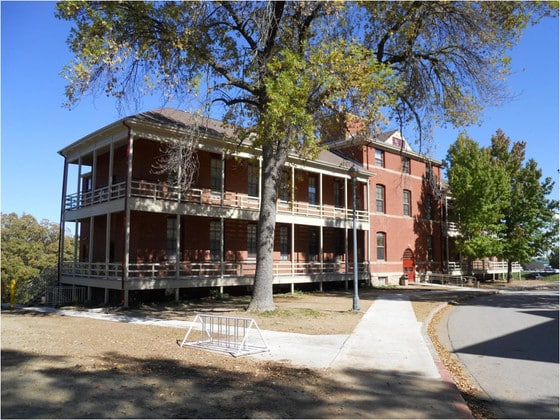| Year(s) Listed: • 2014 |
| City/Town: • Leavenworth |
| Location Class: • Residential |
| Built: 1930 | Year Saved: N/A |
| Awards: • Honor Award |
| Contributor: Kansas Preservation Alliance |
The Western Branch of the National Home for Disabled Veterans was founded by Congress in 1885 as an act of a grateful public to provide a hospital, chapel, mess hall, recreation hall, and domiciliary buildings for veterans of the Civil War, with grounds furnished with bandstands, fountains, and gardens. Over time, an extensive campus was constructed, and in 1930 was incorporated into the new Department of Veterans Affairs. Over time, however, the operations were moved into the new Dwight D. Eisenhower Medical Center campus, and in 1999 the VA proposed the demolition of 38 vacant or underused buildings on the campus, all located within the historic Western Branch, National Home for Disabled Veterans. Through the actions of concerned citizens the buildings were saved and the Eisenhower Ridge Association, led by private developer Pioneer Group, was awarded the 75-year lease to rehabilitate the buildings for new tenants. The Ridge Top Apartments rehabilitation project adapted domiciliary buildings 1 through 4 – the first constructed at the Western Branch in 1866 – into one- and two-bedroom apartments for low-income, veteran transitional housing.
Two historic eras of construction were utilized to guide the rehabilitation, both the original 1860s construction and an extensive remodel of the core areas in the 1950s. In the core areas, the terrazzo floors of the entries and main stairs were refinished, and new elevators to provide ADA access were added. Modern apartment units were created in the wings of the buildings, with original ceiling heights maintained wherever possible. The buildings retained almost half of their original wood windows, which were restored. New wood sashes were replicated and installed where non-historic steel windows were removed. Metal exterior fire escapes were removed, and the neglected exterior masonry was cleaned and repaired. The historic front entrances were recreated from historic photos, replacing non-historic aluminum entrances. Building 61, a two-story brick house, was restored as a single-family rental house, with a renovated kitchen and new mechanical and electrical systems.
Federal and state historic preservation tax credits were utilized to fund this rehabilitation.
The project team included: Pioneer Group; Treanor Architects; Spencer Preservation; Professional Engineering Consultants; Lattimer Sommers & Associates; Bartlett & West, Inc., and Straub Construction.

